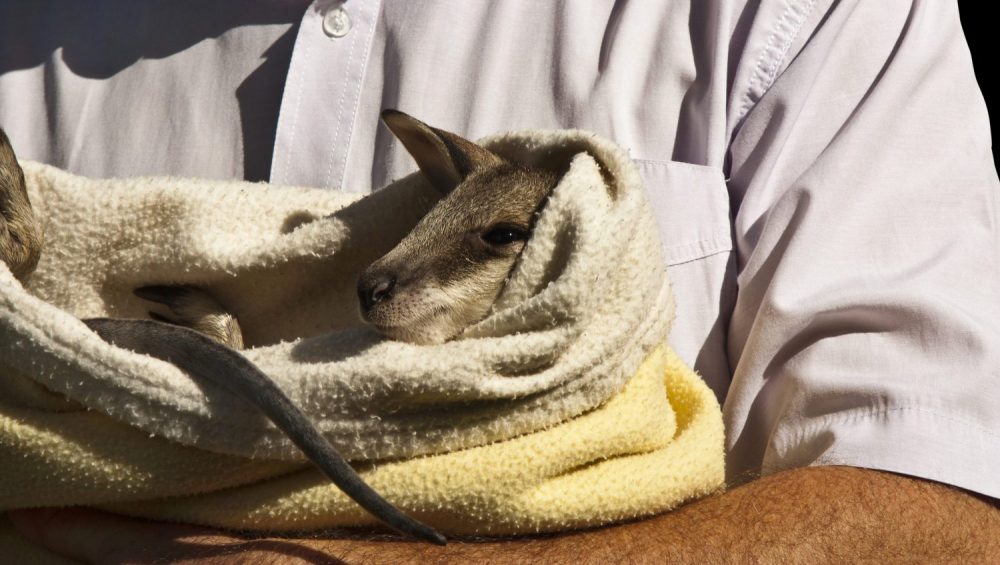
[vc_row][vc_column][vc_column_text]Learning what it takes to become a volunteer wildlife carer
Most of us would do anything to cuddle up to some of Australia’s amazing native wildlife. From feeding joeys in makeshift pouches to teaching baby birds how to fly, becoming a volunteer wildlife carer is a very rewarding and fulfilling experience. Nurturing our unique wildlife and watching them go free into the wild is enough to make your heart sing! But what about the frequent feeding times during the night? What about my pets, is it safe to keep wild animals around them? To answer all your questions, read the article below of an interview with Louise an Animals Australia wildlife carer. Louise talks about the joys and challenges of working as a volunteer wildlife carer.[/vc_column_text][us_separator type=”invisible” size=”small”][vc_row_inner][vc_column_inner][us_single_image image=”8273″ size=”full” align=”center”][/vc_column_inner][/vc_row_inner][us_separator type=”invisible” size=”small”][vc_column_text]How did you become a wildlife carer?
Several years ago while driving I saw a kangaroo who had been killed by a car. I had always assumed that it would be someone’s job to check her pouch for young. I’ve learned since that that’s not actually the case. Wildlife belong to no one, which means these animals are free, but if they are injured or orphaned, they rely on people to volunteer their time to rescue and care for them.
That day I decided to take the dead kangaroo off the road to give her a bit of dignity, and opened her pouch out of curiosity. There was a tiny but very alive joey in there waiting to be rescued. That’s how it all began![/vc_column_text][us_separator type=”invisible” size=”small”][vc_row_inner][vc_column_inner width=”2/3″][vc_column_text]What does a wildlife carer do?
The purpose of a carer’s work is to raise or rehabilitate orphaned or injured native wildlife so that they may be returned to the wild, and live the natural life that was intended for them. They’re not pets; they simply need love and care to help them on their way.
Caring involves feeding, keeping them warm or cool depending on the weather, providing a safe space to live, and making sure they receive any attention they need from a vet.
Most young native animals are fed using a special formula or specialised diet to accurately replicate their natural diet, as human foods can be very harmful for them. They often need feeding every two hours when they’re tiny, with feeding routines gradually changing over a few weeks or months until they’re weaned. It’s also essential that a carer takes steps to prepare them for life in the wild, to ensure they can survive independently once released.
Especially when they’re young, wildlife caring is a round-the-clock job. It takes a lot of dedication.[/vc_column_text][/vc_column_inner][vc_column_inner width=”1/3″][us_single_image image=”8275″ size=”full” align=”center”][/vc_column_inner][/vc_row_inner][us_separator type=”invisible” size=”small”][vc_column_text]What kind of animals do you care for?
Lots of different animals! It depends on who needs care at the time. Possums and kangaroos are the ones I’ve looked after most, but at the moment I’m caring for flying fox pups, who are so adorable. Carers also look after animals like wombats, reptiles and various bird species. All of them have different care requirements, which is part of the reason the work is so interesting.
Note: In order to care for flying foxes you need to ensure you get appropriate vaccinations.
What’s the best thing about being a wildlife carer?
By far, the best thing about being a carer is seeing an animal in your care grow healthy and strong and wild. The sight of a kangaroo taking their first hop or a cockatoo fly to freedom is the most satisfying feeling in the world. The opportunity to be so close to these special species, to observe them and to learn from them is also a huge source of pleasure.
What challenges have you experienced?
Wildlife caring can take over your life. You have to remodel your schedule to put the animals in your care first. A hungry baby possum can’t wait until the shopping is done, a fledgling bird can’t feed herself while you clean the house, and a kangaroo joey will not cope in a noisy environment. Your social life will take a gentle battering!
Money can be a challenge, too. Contrary to popular belief, wildlife caring is not a paid job. Carers do not receive recurrent funding and all expenses are borne by the individual — it can definitely add up. Having said that, it really is worth every cent.
It can also be frustrating and upsetting to see how many native animals are killed or injured by domestic animals, by cars or even by the netting in gardens — or of course when people deliberately harm them. As a wildlife carer I try to educate others where I can about how to minimise harm to native animals.
Who would be suited to wildlife caring?
Dedicated, enthusiastic people with an open mind, who are willing to start learning — and to never stop! Given the time commitment, wildlife caring often suits people who are retired or are part-time workers – although many of us also have full-time jobs.
To see more – http://www.animalsaustralia.org/features/being-a-wildlife-carer.php[/vc_column_text][/vc_column][/vc_row]
